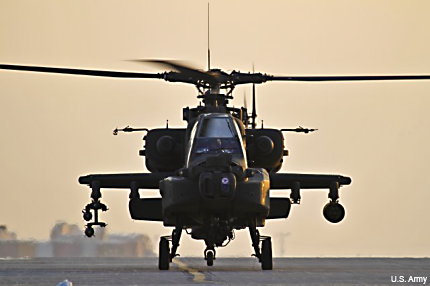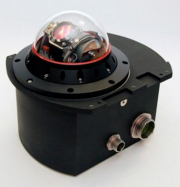Army moves ahead with laser-based aircraft missile defense
The lightweight, modular Common Infrared Countermeasure system can help protect helicopters and small aircraft from ground-launched missiles.

Aircraft such as the AH-64 Apache will get the active infrared laser-based CIRCM system (below).

The Army is getting ready to move to the next phase in the development of a lightweight, laser-based system for protecting helicopters and light aircraft from infrared-seeking missiles.
The Common Infrared Countermeasure, or CIRCM, is being designed to provide automated countermeasures primarily against man-portable air defense systems, which fire missiles from the ground and use infrared capability to guide those missiles, according to an Army release. CIRCM would be used on Army AH-64 Apache and UH-60 Black Hawk helicopters, as well as small tilt-rotor and fixed wing aircraft. The Navy, which is a partner in the project, plans to use the systems on the AH-1 Cobra and MV-22 Osprey, as well as, eventually, the CH-47 Chinook.
Northrop Grumman and BAE Systems have been developing CIRCM under competing technology development contracts first awarded in 2012.
The Army said CIRCM has passed Milestone A in its development and could later this year reach Milestone B, which involves building a system, testing it and achieving a pre-established level of readiness. With Milestone B, one of the two vendors will be chosen to move forward. Past that point is Milestone C, which will begin low-rate initial production of CIRCM. The Army and Navy expect to begin fielding CIRCM in fiscal 2019.
CIRCM is intended to replace older, heavier Advanced Threat Infrared Countermeasures systems with a lighter, modular system that would let CIRCM’s capability be easily swapped from one aircraft to another, depending on the mission, the Army said.
In addition to weight, the new systems provide more firepower and adaptability. "With a laser system, you have unlimited rounds you can dispense against threats," Col. Jong H. Lee, project manager for Aircraft Survivability Equipment, said in the release. And because it’s built with an open architecture, "it's a lot more agile in allowing us to adapt to the threats. It gives us an opportunity to provide increased protection, but also the ability to be adaptable to future threats."
The system consists of a permanently installed A-Kit and a modular B-Kit. The A-Kit contains wiring and harnesses that are installed on an aircraft in a process that can take several hundred hours. The B-Kit, which weighs 85 pounds, contains a pointer/tracker unit, laser and system processor unit, and can be installed on an A-Kit equipped plane in a matter of hours. The Army plans to install 3,000 A-Kits on aircraft and buy 1,000 B-Kits that can be moved around.
Meanwhile, the Army and its contractors are working on reducing the weight of the A-Kit as well. "That's a really big factor," Lee said. "A lot of our Army aircraft don't have excess space or capacity. We wanted to make sure we provide a lightweight system that provides great protection against these threats out there."
Missiles launched from man-portable air defense systems, known as Manpads, typically guide themselves by zeroing in on a target's infrared heat signature. CIRCM works with the Common Missile Warning System aboard aircraft now. CMWS can detect an incoming treat and pass that information to CIRCM, which can then fire a multiband heat laser to intercept and jam the missile.
And the process is entirely automated. "They only have to turn it on," Lee said of pilots. "It's meant to be fully automatic. It really makes it an extremely valuable system for the pilots and the passengers."




